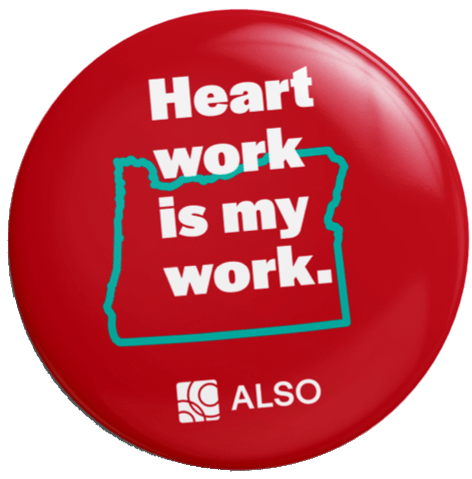Explore the ALSO Children’s Homes Wishlist and help fill the season with joy for the children supported by ALSO.
Explore the ALSO Children’s Homes Wishlist and help fill the season with joy for the children supported by ALSO.

Let’s open our discussion about creating inclusive work environments by talking about Julie, a young woman with an intellectual disability. She tells us about two very different employment experiences.
“They [supervisors] didn’t trust me to do various tasks and my opinions didn’t matter. If I saw something that I disliked and I wanted to change things, it just didn’t matter [to them]. And, you know, the manager and the assistant manager were jerks. He would be constantly watching me and the clock during my coffee breaks.”
Compare the above to her experience after she changed jobs:
“I’m trusted with responsibility, … like I am supervising a discussion group, we have these groups and I’m responsible for one. I get preparation time and my opinion matters.”
In her former position, Julie was one of many people with disabilities who felt marginalized and de-valued, no matter how hard they worked and cared about being excellent, loyal employees. Good thing she knew her worth and chose to change jobs!
Most employers would do anything to get employees like Julie. Surprisingly, people with disabilities represent one of the most underemployed and unemployed populations globally. They constantly struggle with earning less than those without disabilities. To make matters worse, barriers to better education interfere with access to higher-paying jobs. This is despite a worldwide labor shortage. Inclusion of people of all abilities is beneficial to the employment workforce and to overall economic health. Not only are accessible employment opportunities ethically and legally important for all job candidates, but higher employment leads to a world that is more productive, innovative, compassionate, and upwardly mobile.

“Diversity is being invited to the party; inclusion is being asked to dance.” Verna Myers, internationally recognized DEI expert and author
These are wise words spoken by diversity and inclusion expert Vern Myers. Since Ms. Myers made this comment about the difference between diversity and inclusion, employment experts have gone further by emphasizing a reciprocal relationship in which individuals are valued for their unique strengths, differing opinions, and broad range of experiences. In a sense, not only are those with disabilities asked to dance, but they contribute to the playlist! So, we must take the issue of diversity beyond simply compliance with the Americans with Disabilities Act (ADA), and honor the ‘spirit’ of the law by encouraging meaningful belonging.
Disability activist Keith Jones has jarring memories of being Black and having cerebral palsy. He states, “Being Black and a child with cerebral palsy, or ‘crippled’ as I was called, neither I nor my classmates were expected to put forth any effort to learn. So, little effort was spent on teaching us.” The intersection of these two minority categories (race and disability) compounded his struggles for an equitable education that could lead to competitive employment. In addition to race and disability, there are many types of marginalized groups, such as:
These differences intersect to create persons that have unique life experiences, strengths, and individual needs. In the development of the equitable society that we aspire to, these are not liabilities, but advantages that create vibrant and compassionate communities.

As we all know, the lack of an equitable education experienced by Keith Jones and his classmates had a direct effect on the ability to obtain competitive employment. To address these issues, several Oregon state agencies have developed strategies to meet the needs of marginalized populations.
The Oregon Department of Education has established the Equity Lens. This document acknowledges that the future of the state depends upon the unique contribution of all Oregonians. High-quality education and training is a fundamental element in the development of financially secure, productive, and healthy futures. Another state agency, the Oregon Office of Equity and Inclusion, has a crucial role in managing gaps in the treatment of marginalized communities and supporting systemic change.
Such changes are not simply ‘laws’ or ‘regulations.’ But rather they represent the moral and ethical commitment to all Oregonians.
LEARN MORE: Diversity, Equity, and Inclusion Action Plan.
Currently, the ADA makes it unlawful to discriminate in employment practices such as:
LEARN MORE: The ADA – Your Responsibilities as an Employer.
Oregon laws protect employees and job applicants with disabilities. For example, employers aren’t allowed to segregate or classify an employee in a way that adversely affects that person’s job opportunities. Several examples of reasonable accommodation are given in the ORS:
LEARN MORE: Assistive Technology in the Workplace for People with Disabilities.
BOLI plays a major role in enforcing the civil rights of people with disabilities (and other minority groups) in work settings. It applies to employers with at least 6 employees. This is more stringent than Federal Law, which applies to employers with 15 or more employees.
LEARN MORE: Disability Accommodation Toolkit.
From the get-go, employers can create a culture of full inclusion by beginning with the hiring process. Here are a few recommendations:
*Important Tip: Involve people with disabilities in recruitment strategies and outreach efforts.
LEARN MORE: How to Create a ‘Culture of Yes’ in Your Organization.
Educating your entire workforce is a major factor in the development of inclusivity. It’s essential to begin with leadership buy-in so that inclusive behaviors can be modeled appropriately.
Disability Awareness and Etiquette:
Trauma-informed Practice
ALSO service providers have specific training on trauma-informed care (TIC). Persons living with I/DD experience a higher incidence of early trauma, such as bullying, harassment, abuse, and abandonment. Our employment programs are excellent at providing the necessary initial and on-going supports that ensure success in the workplace.
LEARN MORE: Oregon Health Authority Resources on TIC.
Many companies designate an ‘inclusion officer’ or point-person to make recommendations on ways to continuously improve company inclusion practices. This helps to shape best practices in full inclusion. Organizations can also engage in the following:
Let’s get started with this quick, actionable checklist:
Accessible, inclusive, and competitive job opportunities benefit everyone: employers, employees, and communities. We’ve seen with our own eyes how individuals living with even the most significant disabilities can belong and thrive in their communities.

The supported employment programs at ALSO are second to none, achieving state and national recognition for facilitating competitive integrated employment. In addition, we’re highly skilled at working with family members and identifying funding sources to help those that we support succeed in their chosen professions.
We invite you to take a first step by reviewing your hiring practices today, or by contacting ALSO to schedule a consultation. We’re here for you… and we know that progress, not necessarily perfection, makes our communities better places to live and work. One step at a time, we can build a stronger, more equitable Oregon.
Start Now. Start Here.

Sign up for our newsletter to get our latest news, content, and job opportunities.
Help us ensure that everyone has the same opportunities in their home, workplace and community. Let’s make dreams!
